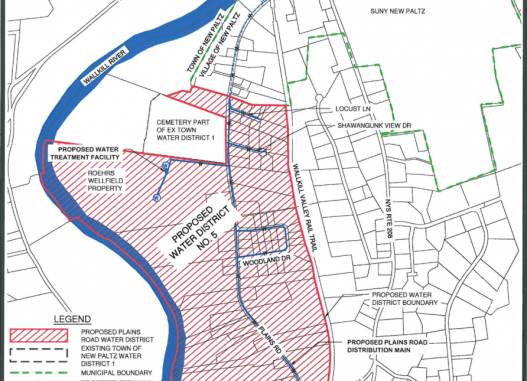
In 13 months, the Catskill Aqueduct will shut down for ten weeks of repairs and service work. During the shutdown, the Village of New Paltz will need to look elsewhere to satisfy its water needs of roughly 600 gallons per minute. Local officials have planned on reaching that number by using several options, but the Plains Road aquifer seems to be the only source that has been at the center of frequent controversy.
“You can’t just start pumping thousands of gallons an hour out of aquifer in a way that would damage the environment,” said Marty Rosenbaum, an Albany attorney, who is currently leading two cases against the project. One case challenges the entire project under the State Environmental Quality Review Act (SEQRA), including the town and village of New Paltz, New York City, and the owner of the testing site on Plains Road. The court has not yet reached a preliminary decision on the case.
The other case, against the town of New Paltz, argues that the water district plan was not detailed enough and would not benefit at least half of the residents. Last month, a state court reached a preliminary decision on the case, and according to Rosenbaum, the case will continue to move forward, which could make things difficult for town officials such as Village Trustee Tom Rocco.
“The most we have to get is the courts to say no, that these suits are not valid reasons not to go forward,” said Rocco. “For that, you need a court decision.”
According to Rocco, the village’s other options for increasing its water output include reservoir expansion and drilling for wells in three other locations. The reservoir expansion would improve its output to 200 to 250 gallons per minute (gpm), while the wells’ combined output would be between 100 and 200 gpm. Another option, a well on the Turk property near S. Ohioville Road and I-87, was considered but discarded when testing showed high salt levels.
Even with conservation efforts, which decrease consumption by five to ten percent, Plains Road’s 400 gpm is necessary to reach demand. Rocco called the water plan “a four-project set that we needed to get to 610 gallons per minute.”
Some residents of Plains Road feel that village officials haven’t considered all options. “I think that the better solution for a temporary problem is a temporary solution,” said Ingrid Beer, a resident represented by Rosenbaum. “A temporary solution, in my opinion, is going to be to pump water from the town of Lloyd into the village for those ten-week shutdowns.”
Google Maps places Lloyd and New Paltz less than five miles away from each other, just a short distance away on Route 299. According to Beer, the village’s response to the solution was that “they don’t have enough time to get the permit.”
Town Supervisor Neil Bettez, however, views the possibility of the Plains Road water district as a windfall. According to Bettez, the New York City Department of Environmental Protection made much of the project possible in the first place, contributing about $10 million – the town’s annual budget.
“They’re pitching in this time because it’s to the DEP’s benefit that we have a backup water supply in case of a catastrophic failure,” he said. “But there’s no guarantee. At some point, if we can’t get all of our ducks in a row, they’ll just walk away from this project… Then we lose out, and the people who lose out are really the people on Plains Road who want and need this water.”
Despite the apparent advantages of the water district, Bettez acknowledged the opposition to the project. “It hasn’t fallen apart yet, but it’s being slowed down by a few people who, I think, are thinking only of themselves, and not their neighbors or community.”
